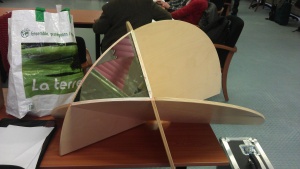Difference between revisions of "Le Labosaïque"
From WikiMathCom
(added image) |
|||
| Line 1: | Line 1: | ||
| − | [http://www.math.unicaen.fr/vulgarisation/Labosaique.html Le Labosaïque] is a project of communication | + | [http://www.math.unicaen.fr/vulgarisation/Labosaique.html Le Labosaïque] is a project of communication about the symmetries of the plane and the space, developed by the Laboratoire de Mathématiques Nicolas Oresme, at University of Caen (France). The project started in 2010, and it won the award Prix Musée Schlumberger in 2011. |
==Exhibits== | ==Exhibits== | ||
Revision as of 16:34, 5 December 2014
Le Labosaïque is a project of communication about the symmetries of the plane and the space, developed by the Laboratoire de Mathématiques Nicolas Oresme, at University of Caen (France). The project started in 2010, and it won the award Prix Musée Schlumberger in 2011.
Exhibits
- About a thousand pieces for assembling periodic tilings with the 17 crystallographic groups. Besides, a device with a rotating and gliding plate allows to overlap a transparent template and move it around to identify the symmetries of the tiling.
- Two mirrored boxes, one in shape of square and another an equilateral triangle. The interior walls of the boxes are mirrored, and sample patterns are put in the bottom of the box, creating symmetric tilings.
- A hinged mirror, to give the visitor some intuition of why the number of tilings is finite and small.
- A thousand pieces to create an aperiodic Penrose tiling.
- Three spherical kaleidoscopes.
Museology
The project got support and inspiration from the institute Matematita in Italy. The spherical kaleidoscopes and mirrored boxes follow the design of those in Matemilano, an exhibition organized by Matematita in Milan in 2003-2004 ([1]). The construction of these two exhibits in Caen was done by the milanese wood artisan Tommaso Letteriello.
